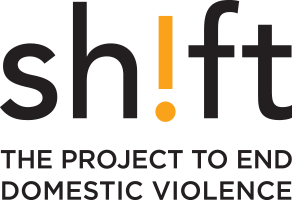The Calling In Men Research Project

What is the Calling In Men Project?
With the support of Women and Gender Equality Canada, Shift undertook a comprehensive review of the academic and grey literature available on engaging and mobilizing men in gender equality and violence prevention.
Our goal was to shed light on what current research is telling us about the most promising approaches for engaging men and to share those learnings across Canada.
We began by talking to diverse male-identified practitioners and subject matter experts from across the country. Of the many promising approaches that were identified, nine were selected for in-depth research.
They are:
- Calling in approach

- Nudge approach
- Social norms approach
- Bystander approach
- Virtual reality approach
- Gamification approach
- Data science approach
- Community justice approach
- Fatherhood approach
We then conducted ‘rapid evidence reviews’ on the 9 selected approaches. A rapid evidence review is a type of knowledge synthesis that includes identifying specific research questions, reviewing the best available evidence to answer those questions, and identifying the key strengths, challenges, and gaps the evidence is pointing to.
The following publications of our findings are available on our website:
These FAQs were created to make the research more accessible and support practitioners to integrate these approaches into their work. Our hope is that the approaches can be adapted by a wide range of people working with men across social justice movements. Whatever your entry point, we believe there are many valuable insights to draw on as we work to build a more just, violence-free, and equitable future.
Why is engaging men necessary to prevent violence and achieve gender equality?
For more than three decades, governments and the anti-violence sector have recognized that men play a critical role in stopping violence before it starts, yet we’ve struggled to prioritize this work and understand how to do it effectively.
In Canada, we know that
- 90% of violent crimes are committed by men,
- 98% of sexual assaults are committed by men, and
- 83% of violence against women is committed by men.
[Sources: Rotenberg, C. 2017; Sinha, M. 2013; Vaillancourt, R. 2010]
But it’s not just women who experience violence resulting from patriarchal systems, colonialism, toxic masculinities, and unhealthy gender norms. Men suffer as well.
Research shows that, compared to women, men have
- higher rates of suicide,
- higher rates of injury and early death,
- higher rates of alcohol and substance abuse, and
- higher rates of mortality and morbidity.
[Sources: Bellette, J.M., & Janz, T., 2015; Navaneelan, T., 2017; Public Health Canada, 2016; Statistics Canada, 2017, 2020]
And the situation is even worse for racialized and Indigenous men who are over-represented in many of these categories.
While men are the primary perpetrators of violence against women and girls, men are also the primary perpetrators of violence against men and boys, which makes them frequent victims of violence, abuse, and trauma.
The way that we socialize men not only harms women – it also harms men.
That’s why engaging men as co-beneficiaries and agents of change for equality, justice, and inclusion is essential in the prevention of violence.
Our aim is never to make excuses for men or diminish the necessity of holding men accountable. Rather, we are seeking to improve our approach to accountability so that we can mobilize men to ultimately prevent violence from happening in the first place.
By engaging men with strategies that “meet them where they’re at” and providing opportunities for transformational learning, healing, accountability, and repair, we can create effective conditions that change hearts, minds, and (most importantly) behaviours. We can build momentum for bigger and more impactful social and gender justice movements.


Calling In Approach
What is a Calling in approach?
Calling in is a term first credited to Ngọc Loan Trần, a Việt/mixed-race disabled queer writer and educator based in the U.S. South. It is a practice of inviting people or organizations who are causing or have caused harm into a conversation in which learning and growth are the goals.

Nudge Approach
What is a nudge approach?
Our decisions are highly influenced by our physical, institutional, and sociocultural context, which means that even seemingly unimportant details in our environment can influence us without us consciously noticing. Nudge approaches are designed to influence behaviour by making small, strategic changes to things like processes, social environments, and physical spaces.

Social Norms Approach
What is a social norms approach?
We’re all familiar with social norms, even if we don’t always stop to consider how they might be impacting our decisions and behaviour. Social norms are those unspoken or sometimes explicit guidelines we follow when it comes to the behaviour we expect from ourselves and others. Social norms are specific to a community and can vary across groups and cultures. Shaking hands when you meet someone new is an example of a social norm.

Bystander Approach
What is a bystander approach?
We’ve likely all had the experience of witnessing a conversation or a situation that left us uncomfortable or even deeply concerned. We probably wondered to ourselves, should I do something? What CAN I do? Maybe we didn’t notice the warning signs.

Virtual Reality Approach
What is a virtual reality approach?
The virtual reality (VR) approach uses virtual simulations to allow users to gain different “embodied perspectives”, explore decision-making, and practice skills in a hyper-real environment. Many of us have had the opportunity to explore a virtual world through gaming as they are becoming more commonplace.

Gamification Approach
What is a gamification approach?
If you’ve ever found learning was easier when you were having fun, you were likely experiencing some type of gamification. Gamification approaches use game design techniques to motivate participants towards a specific outcome, such as increased knowledge or behaviour change.

Data Science Approach
What is a data science approach?
Data science is a multidisciplinary field of study that focuses on creating, collecting, handling, and analyzing large amounts of data to extract actionable insights. Data scientists use scientific methods to develop algorithms that identify patterns in order to help predict future events, reduce risk, and improve outcomes.

Community Justice Approach
What is a community justice approach?
Community justice is an umbrella term for justice approaches that focus on community-level outcomes that support survivors, hold offenders accountable, strengthen positive community norms, and change inequitable structures. Community justice approaches are understood as alternative solutions to our legal system. These practices have long and experienced histories in Indigenous, Black, and racialized communities.

Fatherhood Approach
What is a fatherhood approach?
A fatherhood approach includes a range of different programs and initiatives that aim to increase positive involvement of fathers in their children’s lives. This includes things like taking an active role in caring for their child’s social, emotional, cognitive, and physical health and having a respectful relationship with the child’s mother or co-parent.
Who contributed to the research project?
These FAQs are adapted from research that included the following authors and contributors:
Authors:
Laura Pascoe
Lana Wells
Elizabeth Dozois
Elizabeth (Liz) Baker
S. Hamid Akbary
Brian Hansen
Research Assistants & Administrators:
Elena Esina
Naomi Phung
Winta Ghidei
Winta Abera
Male Practitioners and Experts:
Jake Stika
Aslam Bubulia
Abbas Mancey
Ayrah Taerb
Jared Cline
Todd Minerson
Jeff St. John


